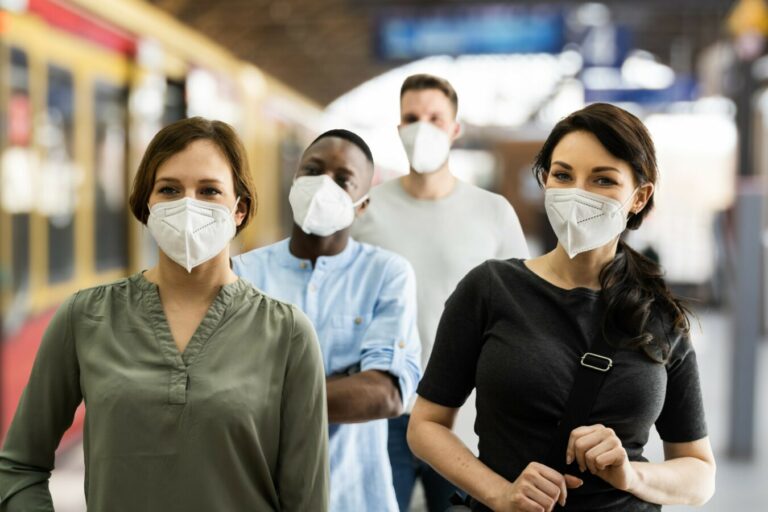As the pandemic carries on, top minds in science continue to learn more about the COVID-19 virus and its variants. While we can be confident in the fact that the science is constantly changing (and that’s a good thing), it’s not always easy to access this information in concise formats – especially in terms you don’t need an epidemiology degree to understand. Below, we highlight some of the most important things to know about navigating the pandemic today, from staying safe to translating the CDC’s most recent recommendations.
Keep a couple of at-home kits on hand
On January 19, 2022, the Biden Administration officially launched its free COVID-19 test kit program. One member per US household can enter their contact and shipping information and receive four free rapid COVID-19 tests. Please only use this website, and do not pay any money at checkout on any other site, as the government-issued tests are free and will not require any form of payment. Also, make sure to coordinate with your family members or roommates as only four free tests will be issued to a single, valid US address, even if there are more than four people living there. Here’s that URL again: https://special.usps.com/testkits
Understand isolation vs. quarantine
In a recent blog, we focused on decoding the CDC’s latest guidelines on isolation and quarantine, including shortened time frames and new mask guidelines. Read it here.
The right mask matters
To effectively protect yourself and others from the highly contagious Omicron variant, the CDC strongly recommends wearing a KN95 or N95 respirator mask that specifically filters viral sized particulates. A full list of NIOSH-approved N95 masks can be found on the CDC’s website along with recommendations on what brands and models will best suit your specific needs.
Unfortunately, your carefully curated fabric mask collection has to be sidelined, as fabric – even multiple layers of it – is simply too porous for the highly virulent Omicron particles that easily slip into and out of this material. Meanwhile, KN95s and N95s protect you and others by providing more of a shield, keeping your germs in, and others’ out.
Buyer beware: per the CDC, roughly 60% of KN95 respirators in the US are counterfeit and don’t meet NIOSH requirements. Click here for the full list of those, which include some Amazon best sellers.
Some can get their boosters sooner
Another update: the CDC now recommends that people who got the two-dose Pfizer-BioNTech vaccine can get their boosters five months after their original shots (instead of six months). The six-month recommendation for those who received the Moderna vaccine, and the two-month guideline for anyone with the J&J vaccine, remain in place.
Kids and vaccines
Currently, children ages 0-4 are still the only group not eligible to receive the COVID-19 vaccine. This is unfortunate, as the CDC reported a surge in hospitalizations of this age group over the past two weeks. As The New York Times notes, there has not been a spike in other age groups.
There are a few reasons why this spike may be happening:
- “The more children get infected, the more you’re going to have kids who are going to be sick enough to be hospitalized,” says Yvone Maldonado, Chair of the committee of Infectious Diseases at American Academy of Pediatrics
- Doctors may be quicker to admit after the Delta surge
- Young children are particularly vulnerable to infections in the upper airway, and Omicron specifically seems to target upper airway
Current stats via Mayo Clinic:
- Children ages
- 0-4 are not vaxxed
- 5-11 – 18.8% are fully vaxxed
- 12-17 – 54.6% are fully vaxxed
That means:
- Get everyone eligible in household and who comes in contact with your children vaccinated
- Invest in KN95 or N95 masks
- Do not let your guard down
What is Flurona?
Flurona is not a new disease, rather it is a term coined by global media outlets to describe a patient’s state of co-infection with influenza (the flu) and COVID-19. Testing positive for both viruses simultaneously is very rare as any strain of COVID-19 virus will quickly overtake the flu. So, while it is possible to be co-infected, it is not common.
Additionally, an immune system that is already lowered from contracting and battling COVID-19 may be more susceptible to flu – and vice versa. In light of the current Omicron variant COVID-19 surge, the CDC and we recommend both the COVID-19 vaccine and booster and the flu vaccine.
Don’t be careless about COVID-19
As much as we all want to believe that Omicron is “not that bad” and that “everyone is going to get it anyway,” let’s revisit the CDC’s symptom definition of a mild case of COVID-19:
- Fever – temperature of at least 100.4℉
- Cough – dry cough in upper or lower respiratory system
- Sore throat
- Congestion/runny nose
- Malaise – “an indefinite feeling of debility or lack of health often indicative of or accompanying the onset of an illness”
- Headache
- Muscle pain
- Nausea and/or vomiting
- Diarrhea
- Loss of taste and/or smell
These are all considered mild symptoms of all COVID-19 strains and can last from days to weeks. Unless a patient has shortness of breath, labored breathing or a severe case of any other above symptoms, they are encouraged to self-treat at home with OTC medications. Even if a person with a mild case goes to the ER, they may not receive the FDA-approved emergency use therapies, as they are generally used in moderate and severe cases, and are often in short supply. All strains of COVID-19, including Omicron, can cause long-haul COVID-19 and thus should be taken seriously.
Questions? Concerns? General desire to vent about the often-confusing messaging we’re receiving during the pandemic? We’re here for you – contact us today.

